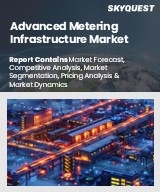
첨단 계측 인프라 세계 시장 규모는 2023년에 63억 달러, 2024년 70억 1,000만 달러에서 2032년에는 163억 8,000만 달러로 성장하고, 예측 기간(2025-2032년) CAGR은 11.2%를 나타낼 전망입니다.
스마트 그리드 기술과 디지털 인프라의 발전으로 인해 AMI(Advanced Metering Infrastructure) 시장이 크게 성장할 것으로 예상되며, AMI 기술을 기존 전력망 시스템에 통합하는 것이 중요한 원동력이 되어 유틸리티 기업이 에너지 분배를 자동화하고, 효율성을 높이고, 실시간 데이터 수집을 통해 정전 관리를 개선할 수 있게 됩니다. 실시간 데이터 수집을 통해 정전 관리를 개선할 수 있게 됩니다. 세계 각국 정부는 에너지 절약과 이산화탄소 감축을 우선시하는 규제 프레임워크에 힘입어 지속 가능한 에너지 네트워크를 구축하기 위해 전력망 현대화 프로젝트에 착수하고 있습니다. 예를 들어, 유럽연합(EU)이 2024년에 갱신하는 에너지 효율 지침은 독일, 프랑스 등의 국가에서 스마트 미터 도입을 촉진하고 있습니다. 또한, AMI 기업용 서비스는 유틸리티 기업들에게 업무 간소화, 양방향 커뮤니케이션 채널을 통한 고객 참여 강화, 실시간 에너지 모니터링 및 수요 대응 이니셔티브 참여를 가능하게 하는 등 필수적인 요소로 자리 잡고 있습니다.
Global Advanced Metering Infrastructure Market size was valued at USD 6.3 billion in 2023 and is poised to grow from USD 7.01 billion in 2024 to USD 16.38 billion by 2032, growing at a CAGR of 11.2% during the forecast period (2025-2032).
The global advanced metering infrastructure (AMI) market is set for notable growth driven by advancements in smart grid technology and digital infrastructure. The integration of AMI technologies into existing grid systems is a key catalyst, enabling utilities to automate energy distribution, enhance efficiency, and improve outage management through real-time data collection. Governments worldwide are initiating grid modernization projects to create sustainable energy networks, propelled by regulatory frameworks prioritizing energy conservation and carbon reduction. For example, the updated Energy Efficiency Directive from the European Union in 2024 is prompting smart meter adoption in countries like Germany and France. Additionally, AMI enterprise services are becoming essential for utilities, streamlining operations and enhancing customer engagement via two-way communication channels, enabling real-time energy monitoring and participation in demand-response initiatives.
Top-down and bottom-up approaches were used to estimate and validate the size of the Global Advanced Metering Infrastructure market and to estimate the size of various other dependent submarkets. The research methodology used to estimate the market size includes the following details: The key players in the market were identified through secondary research, and their market shares in the respective regions were determined through primary and secondary research. This entire procedure includes the study of the annual and financial reports of the top market players and extensive interviews for key insights from industry leaders such as CEOs, VPs, directors, and marketing executives. All percentage shares split, and breakdowns were determined using secondary sources and verified through Primary sources. All possible parameters that affect the markets covered in this research study have been accounted for, viewed in extensive detail, verified through primary research, and analyzed to get the final quantitative and qualitative data.
Global Advanced Metering Infrastructure Market Segments Analysis
Global Advanced Metering Infrastructure Market is segmented by Component, Communication Technology, End Use, Application and region. Based on Component, the market is segmented into Smart Meters, Communication Network, Meter Data Management System (MDMS) and Head-end Systems. Based on Communication Technology, the market is segmented into RF Mesh, Power Line Communication (PLC), Cellular, Wi-Fi and Others (ZigBee, Satellite, etc.). Based on End Use, the market is segmented into Residential, Commercial and Industrial. Based on Application, the market is segmented into Electricity, Water and Gas. Based on region, the market is segmented into North America, Europe, Asia Pacific, Latin America and Middle East & Africa.
Driver of the Global Advanced Metering Infrastructure Market
The global Advanced Metering Infrastructure (AMI) market is significantly driven by the escalating initiatives aimed at developing smart grids. Governments and utility companies are making substantial investments to upgrade electrical infrastructures, optimizing grid functionality and minimizing energy waste. AMI systems are crucial for these smart grids, facilitating real-time data acquisition, automated meter readings, and adaptive pricing for energy consumption. Notably, in April 2024, the U.S. Department of Energy initiated a robust $3.5 billion program focused on smart grid modernization, which encompasses the extensive rollout of AMI systems across various states to enhance grid reliability and improve outage management practices.
Restraints in the Global Advanced Metering Infrastructure Market
The Global Advanced Metering Infrastructure market faces significant restraints primarily due to the high initial costs related to smart meter hardware, communication networks, and data management systems. These financial hurdles are particularly pronounced for utilities in developing countries, where budget limitations and unclear timelines for return on investment deter many from making the necessary investments. In Latin America, several mid-sized utility companies have delayed their smart meter implementation projects as a result of rising import expenses and fluctuating currency values, putting their modernization efforts on hold. This reluctance to invest in advanced metering technology poses a challenge to market growth.
Market Trends of the Global Advanced Metering Infrastructure Market
The Global Advanced Metering Infrastructure (AMI) market is witnessing a significant trend towards the integration of Artificial Intelligence (AI) and predictive analytics, reshaping operational efficiencies in the energy sector. This technological advancement facilitates predictive maintenance, real-time energy theft detection, and accurate consumption forecasting, empowering utilities to make informed decisions that optimize resource management. A notable player in this evolving landscape, GridIntelli, recently unveiled an AI-driven analytics platform that has demonstrated substantial success in Canada by enhancing anomaly detection and predicting peak loads, resulting in a remarkable 25% reduction in system downtime. This trend underscores the importance of data-driven strategies in driving the future of AMI solutions.